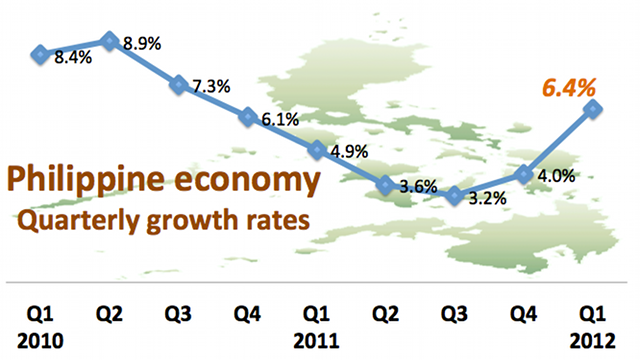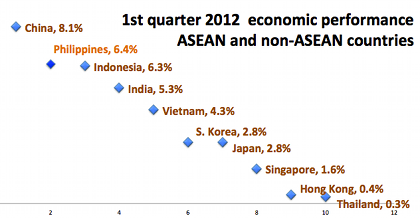SUMMARY
This is AI generated summarization, which may have errors. For context, always refer to the full article.

MANILA, Philippines [2nd UPDATE] – In the first 3 months of 2012, the Philippine economy posted a surprising 6.4% growth — higher than the expections of market players, economists, funding institutions and even the government itself.
This economic performance is the second highest quarterly growth for the Aquino administration and “the highest first quarter performance in a non-election year since 2006,” noted the Aquino government.
This better-than-expected performance was largely due to strong services and industry sectors, which grew 8.5% and 4.9%, respectively.
The government cited the 16% increase in tourist arrivals (1.15 million tourists in first quarter), healthy appetite for real estate units, and retail performance for the strong performance of the service sector, which contributed almost 3/4 to the GDP growth.
Remittances, which remained resilient despite the global economic woes, boosted consumer spending. Money sent home by Filipinos working and living abroad amounted to US$4.8 billion in the first quarter.
“[The first quarter growth] was also supported by infrastructure spending and CCT (Conditional Cash Transfer) program of the government,” explained recently named Economic Planning Secretary Arsenio Balisacan during a press briefing on Thursday, May 31.
This good news comes amid the worsening eurozone crisis, which had dampened demand for Philippine exports, as well as government underspending.
The preliminary first quarter performance beat even the government’s own forecast of between 5% and 6%. The first quarter gross domestic product (GDP) growth rate is typically the weakest.
The GDP measures the total value of all goods and services produced over a period of time and is considered one of the primary measures of a country’s economic health.
“The first quarter GDP figure validates the optimistic outlook of the President and his economic team,” the Palace said in a statement on May 31.
“As the Aquino administration has been resolute in carrying out its agenda of reform and in institutionalizing good governance, it will continue to be equally steadfast in translating our economy’s gains into employment opportunities, programs geared toward poverty alleviation, and the systemic improvement of the way of life of Filipinos,” it added.
Better than neighbors
The Philippines has often been seen as a laggard living in a high-growth neighborhood of South East Asian countries. While last year, the Philippines GDP was below many of its regional peers, the 6.4% first quarter performance was stronger than most of its neighbors.

“Given the preliminary first quarter estimate, we expect the full year 2012 target of 5% to 6% is well within range or we may even exceed it,” Balisacan said.
“We want to keep the momentum going to meet 7% to 8% growth,” the economic planning chief said.
“Government will not let up in its efforts to accelerate the growth of the economy. There is room for faster government spending and the government remains vigilant to threat to growth, including the eurozone, the debt problem in Europe and uncertainties in oil prices,” he added.
Infrastructure
“Growth over the near term will be supported by major infrastructure projects identified by the PPP (public private partnership) projects,” Balisacan explained.
“Twenty-two (22) projects have been identified under the PPP as of May 2012. These are mainly for transportation connectivity, such as roads and airports,” he added.
So far, none of the big-ticket infrastructure projects trumpeted by the Aquino government in 2010 has been successfully bidded out. Even the medium-sized Daang Hari road project awarded in late December 2011 has yet to commence construction.
Previously, the Department of Public Works and Highways chief said they instituted reforms in the award of road contracts to rid the system of corruption. But these resulted in project delays. The goal was to start construction works during the first 6 months of 2012, or before the rainy season sets in.
These delays backfired when the government missed its 2011 annual target and achieved a lackluster 3.7% increase in GDP (revised upward to 3.9%). While part of the blame for the sluggish growth was attributed to global economic woes and bad weather, much of the criticism rested on the shoulders of President Aquino, whose administration was criticized for delaying government spending on crucial infrastructure.
“It would be quite hard to duplicate the bad growth rates of 2011, so at this point there is really no where to go but up. The administration will have to work very hard to do worse and from all indications it doesn’t intend to,” said Ramos-era finance secretary Roberto de Ocampo at Arangkada Philippines Forum in January.
Sustaining the growth
How the government will sustain this growth remains to be seen. Balisacan, who assumed the top post at the National Economic Development Authority (NEDA) a few weeks ago, has said the goal is to pursue an “inclusive growth” or one that trickles to the poor.
He had said that, while most of the high-profile PPP projects are focused on Metro Manila, the poor are mostly in the provinces, and could benefit more from farm-to-market roads, as well as irrigation projects.
The first quarter data showed that agriculture and fisheries sector grew by a paltry 1%. Balisacan, a poverty expert, had said he would prefer to see this long-neglected sector perform better.
Other key factors cited in the first quarter growth face challenges.
Global trade remains worrisome amid the crisis in the west. And China, a key regional trade partner of the Philippines, is expecting a slower growth of 8.2% in 2012.
This was reflected in the Philippine exports and imports data.
![[Graph] Drop of demand for Philippine products](http://go.rappler.com/images/Exports-2012March.png)
Imports performance, which tend to forecast exports growth, also fell 3.3% in March. Economist Benjamin Diokno said this could be a “bad omen,” indicating there could be continued decline in demand for the country’s goods in the coming months.
On the other hand, remittances from overseas Filipino workers (OFW), which fuel consumer spending and investments in real estate, have been reaching record highs.
However, the pace of remittance growth has been slowing down.
![[Graph] Pace of growth of remittances](http://go.rappler.com/images/Remittances-2012-Q1-growth-carousel.png)
The China factor
Meantime, the sea spat with neighbor China over disputed waters in the South China Sea (also called West Philippine Sea) has led to two issues that have an impact on Philippine economy.
The travel advisory issued by China to its citizens may have an impact on the Philippines’ target of 4.2 million tourists in 2012. China is the Philippines’ 4th largest tourism market and the fastest growing source of tourists.
China also accounts for 14.9% of the Philippines’ total exports, with shipments amounting to $642.07 million. This trade relationship with China was highlighted when several Philippine banana shipments since March were not allowed entry into Chinese ports.
Of the Philippines’ trade and other economic partners, the impact of China is more prominent than the European Union’s or the United States’, according to World Bank’s lead economist for the Philippines, Rogier van den Brink, in a recent briefing.
Sprint and a marathon
For some, however, the Philippine economy seems to be gaining speed.
Thus far this year, the Philippines Stock Exchange has outpaced benchmark indexes in Malaysia and Indonesia. The main index has reached 19 record highs since the start of 2012.
The peso has also continued to gain strength, while the country moved a step closer to reaching investment grade. International debt watcher Moody’s Investor Service revised the country’s outlook to ‘stable,’ citing fiscal improvements.
President Aquino has said he does not want the Philippines to be left behind its neighboors and called the race to progress “both a sprint and a marathon.” Though not as fast as some may like, the Philippine economy has picked up speed in the first quarter.
Still the World Bank only forecast a 4.2% growth for the year. While the Asian Development Bank expects 4.8%. Both are a far reach from the 7% to 8% Aquino said the country needs for sustained growth.
The real question is what pace the country can keep for the rest of the year and in the marathon towards progress. – Rappler.com
Click on the links for more.
Add a comment
How does this make you feel?
There are no comments yet. Add your comment to start the conversation.